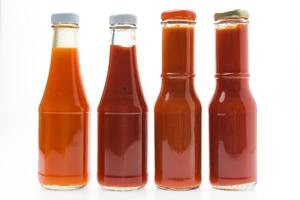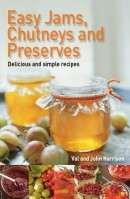Sauces and ketchups (catsup) are very similar although, generally, ketchups have a slightly thinner consistency than sauces.
 Sauces are rubbed through a sieve to give a smooth mixture and then cooked again until they are thick enough not to separate out on standing but will still pour – they thicken as they cool.
Sauces are rubbed through a sieve to give a smooth mixture and then cooked again until they are thick enough not to separate out on standing but will still pour – they thicken as they cool.
Ketchups are often strained through a jelly bag to produce a smooth puree before bottling. Both are made from similar ingredients to those used for chutneys, with the preparation and method also alike.
You won’t need any other equipment beyond that for making chutney but some ketchups and sauces are going to be better stored in bottles rather than jars. Finding small glass bottles is becoming more difficult as the manufacturers resort to plastic which saves them money so save any you come across. One rather good bottle, especially for ketchups, is the continental lager bottle type sold as preserving bottles in some shops and online with a plastic cork held in a metal frame.
Secondary Sterilising for Sauces and Ketchups
Sauces that are made from ingredients low in acid content, e.g. mushrooms and ripe tomatoes, have to be further sterilized after bottling or they may go off. To do this place the bottles in a deep container with a false bottom, making sure they do not touch each other or the sides of the container.
You need to keep the bottles off the base of the pan or the direct heat is likely to cause them crack and you can end up with a real mess to clean up. Although you can buy purpose made sterilizers, complete with false bottom and thermostatic control, they’re quite easy to improvise. We use our ancient hi-dome pressure cooker, which comes with a metal trivet that sits on the base of the pan creating a small gap but you can use any large deep pan, a preserving pan is fine and use something like a metal cake rack to prevent that direct contact. We’ve read that you can use folded newspaper for the task but not tried that ourselves.
Fill the pan with warm water to just below the rim of the bottles and then heat the water gently. If you’re using screw tops, tighten the top and then release by half a turn. If you’re using a plastic cork type of lid, leave on but loose.
You can cap off with conventional wine bottle style corks. These need to be new and then boiled for 10 minutes to sterilise and soften them before inserting part way into the bottle.
This secondary sterilisation can be a bit tricky. You don’t want to keep boiling the ketchup but you need to get the temperature up enough to ensure most spoilage organisms are killed off. It’s more like pasteurising than sterilising.
The temperature you are aiming for is 77 degrees Celsius which is easy to measure with a sugar thermometer. If you don’t have a sugar thermometer then take the water to the point where small bubbles are rising from the base and slightly steaming. Hold at that temperature for 30 minutes
Carefully remove the bottles and allow them to cool down and then tighten the screwtop or cork. Corks are not airtight so you need to further seal them. You can use candle wax dripped on or the plastic sleeves designed for wine bottles that seal when heated with a hair dryer.
All in all, screw tops or the lager style bottles (also called preserving bottles and available online) are far easier.
Recipes For Sauces & Ketchups
- Tartar Sauce Recipe
- Gooseberry Ketchup Recipe
- Mustard Sauce Recipe
- Mushroom Ketchup Recipe
- Tomato Sauce Recipe
- Mint Sauce Recipe
- Horseradish Sauce Recipe
- Cranberry Sauce Recipe
- Spicy Tomato Sauce Recipe
- Chilli Sauce Recipe
- Thai Sweet Chilli Sauce Recipe
More on Preserves
- Fruit Butters & Cheeses
- Fruit Curds – How To Make Fruit Curd
- Pickles – How to Make Pickles
- Relishes – How to Make Relishes at Home


